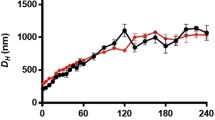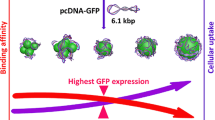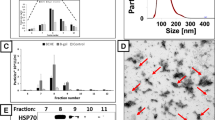Abstract
Transfection efficiency is directly associated with the expression level and quantity of recombinant protein after the transient transfection of animal cells. The transfection process can be influenced by many still-unknown factors, so it is valuable to study the precise mechanism and explore these factors in gene delivery. Polyethylenimine (PEI) is considered to have high transfection efficiency and endosome-disrupting capacity. Here we aimed to investigate optimal conditions for transfection efficiency by setting different parameters, including salt ion concentration, DNA/PEI ratio, and incubation time. We examined the PEI–DNA particle size using a Malvern particle size analyzer and assessed the transfection efficiency using flow cytometry in Chinese hamster ovary-S cells. Salt ions, higher amounts of PEI tended to improve the aggregation of PEI–DNA particles and the particle size of PEI–DNA complexes and the transfection efficiency were increased. Besides, the particle size was also found to benefit from longer incubation time. However, the transfection efficiency increased to maximum of 68.92 % at an incubation time of 10 min, but decreased significantly thereafter to 23.71 %, when incubating for 120 min (P < 0.05). Besides, PEI–DNA complexes formed in salt-free condition were unstable. Our results suggest DNA and PEI incubated in 300 mM NaCl at a ratio of 1:4 for 10 min could achieve the optimal transfection efficiency. Our results might provide guidance for the optimization of transfection efficiency and the industrial production of recombinant proteins.




Similar content being viewed by others
References
Baldi L, Muller N, Picasso S, Jacquet R, Girard P, Thanh HP, Derow E, Wurm FM (2005) Transient gene expression in suspension HEK-293 cells: application to large-scale protein production. Biotechnol Prog 21:148–153. doi:10.1021/bp049830x
Boussif O, Lezoualc’h F, Zanta MA, Mergny MD, Scherman D, Demeneix B, Behr JP (1995) A versatile vector for gene and oligonucleotide transfer into cells in culture and in vivo: polyethylenimine. Proc Natl Acad Sci USA 92:7297–7301
Chen T, Wang Z, Wang R, Lu T, Wang W (2007) Polyethylenimine-DNA solid particles for gene delivery. J Drug Target 15:714–720
Coupin GT, Muller CD, Remy-Kristensen A, Kuhry JG (1999) Cell surface membrane homeostasis and intracellular membrane traffic balance in mouse L929 cells. J Cell Sci 112:2431–2440
Derouazi M, Girard P, Van Tilborgh F, Iglesias K, Muller N, Bertschinger M, Wurm FM (2004) Serum-free large-scale transient transfection of CHO cells. Biotechnol Bioeng 87:537–545. doi:10.1002/bit.20161
Fitzsimmons RE, Uludag H (2012) Specific effects of PEGylation on gene delivery efficacy of polyethylenimine: interplay between PEG substitution and N/P ratio. Acta Biomater 8:3941–3955
Galbraith DJ, Tait AS, Racher AJ, Birch JR, James DC (2006) Control of culture environment for improved polyethylenimine-mediated transient production of recombinant monoclonal antibodies by CHO cells. Biotechnol Prog 22:753–762. doi:10.1021/bp050339v
Garnett MC (1999) Gene-delivery systems using cationic polymers. Crit Rev Ther Drug Carrier Syst 16:147–207
Godbey WT, Wu KK, Mikos AG (1999) Poly(ethylenimine) and its role in gene delivery. J Control Release 60:149–160
Godbey WT, Wu KK, Mikos AG (2001) Poly(ethylenimine)-mediated gene delivery affects endothelial cell function and viability. Biomaterials 22:471–480
Goula D, Remy JS, Erbacher P, Wasowicz M, Levi G, Abdallah B, Demeneix BA (1998) Size, diffusibility and transfection performance of linear PEI/DNA complexes in the mouse central nervous system. Gene Ther 5:712–717. doi:10.1038/sj.gt.3300635
Jere D, Xu CX, Arote R, Yun CH, Cho MH, Cho CS (2008) Poly(beta-amino ester) as a carrier for si/shRNA delivery in lung cancer cells. Biomaterials 29:2535–2547. doi:10.1016/j.biomaterials.2008.02.018
Jordan M, Schallhorn A, Wurm FM (1996) Transfecting mammalian cells: optimization of critical parameters affecting calcium-phosphate precipitate formation. Nucleic Acids Res 24:596–601
Kichler A, Leborgne C, Coeytaux E, Danos O (2001) Polyethylenimine-mediated gene delivery: a mechanistic study. J Gene Med 3:135–144. doi:10.1002/jgm.173
Kircheis R, Wightman L, Wagner E (2001) Design and gene delivery activity of modified polyethylenimines. Adv Drug Deliv Rev 53:341–358
Kunert R, Vorauer-Uhl K (2012) Strategies for efficient transfection of CHO-cells with plasmid DNA. Methods Mol Biol 801:213–226. doi:10.1007/978-1-61779-352-3_14
Lungwitz U, Breunig M, Blunk T, Gopferich A (2005) Polyethylenimine-based non-viral gene delivery systems. Eur J Pharm Biopharm 60:247–266
Mao HQ, Roy K, Troung-Le VL, Janes KA, Lin KY, Wang Y, August JT, Leong KW (2001) Chitosan-DNA nanoparticles as gene carriers: synthesis, characterization and transfection efficiency. J Control Release 70:399–421
McBain S, Yiu H, El Haj A, Dobson J (2007) Polyethyleneimine functionalized iron oxide nanoparticles as agents for DNA delivery and transfection. J Mater Chem 17:2561–2565
Meissner P, Pick H, Kulangara A, Chatellard P, Friedrich K, Wurm FM (2001) Transient gene expression: recombinant protein production with suspension-adapted HEK293-EBNA cells. Biotechnol Bioeng 75:197–203. doi:10.1002/bit.1179
Neu M, Fischer D, Kissel T (2005) Recent advances in rational gene transfer vector design based on poly(ethylene imine) and its derivatives. J Gene Med 7:992–1009. doi:10.1002/jgm.773
Remy-Kristensen A, Clamme JP, Vuilleumier C, Kuhry JG, Mely Y (2001) Role of endocytosis in the transfection of L929 fibroblasts by polyethylenimine/DNA complexes. Biochim Biophys Acta 1514:21–32
Ren Y, Jiang X, Pan D, Mao HQ (2010) Charge density and molecular weight of polyphosphoramidate gene carrier are key parameters influencing its DNA compaction ability and transfection efficiency. Biomacromolecules 11:3432–3439. doi:10.1021/bm1009574
Sharma VK, Thomas M, Klibanov AM (2005) Mechanistic studies on aggregation of polyethylenimine-DNA complexes and its prevention. Biotechnol Bioeng 90:614–620. doi:10.1002/bit.20444
Shi C, Shin YO, Hanson J, Cass B, Loewen MC, Durocher Y (2005) Purification and characterization of a recombinant G-protein-coupled receptor, Saccharomyces cerevisiae Ste2p, transiently expressed in HEK293 EBNA1 cells. Biochemistry 44:15705–15714. doi:10.1021/bi051292p
Swanson JA, Watts C (1995) Macropinocytosis. Trends Cell Biol 5:424–428
Tait AS, Brown CJ, Galbraith DJ, Hines MJ, Hoare M, Birch JR, James DC (2004) Transient production of recombinant proteins by Chinese hamster ovary cells using polyethyleneimine/DNA complexes in combination with microtubule disrupting anti-mitotic agents. Biotechnol Bioeng 88:707–721. doi:10.1002/bit.20265
Wang F, Wang TY, Tang YY, Zhang JH, Yang XJ (2012) Different matrix attachment regions flanking a transgene effectively enhance gene expression in stably transfected Chinese hamster ovary cells. Gene 500:59–62
Wightman L, Kircheis R, Rossler V, Carotta S, Ruzicka R, Kursa M, Wagner E (2001) Different behavior of branched and linear polyethylenimine for gene delivery in vitro and in vivo. J Gene Med 3:362–372. doi:10.1002/jgm.187
Zauner W, Farrow NA, Haines AM (2001) In vitro uptake of polystyrene microspheres: effect of particle size, cell line and cell density. J Control Release 71:39–51
Acknowledgments
This project was sponsored by the National Science & Technology Major Project of China (Key Innovative Drug Development), No. 2011ZX09202-301-14, Shanghai Jiao Tong University. Innovation Fund for Small Technology-based Firms (PKC2013-205) was also greatly appreciated.
Conflict of interest
None.
Author information
Authors and Affiliations
Corresponding authors
Rights and permissions
About this article
Cite this article
Sang, Y., Xie, K., Mu, Y. et al. Salt ions and related parameters affect PEI–DNA particle size and transfection efficiency in Chinese hamster ovary cells. Cytotechnology 67, 67–74 (2015). https://doi.org/10.1007/s10616-013-9658-z
Received:
Accepted:
Published:
Issue Date:
DOI: https://doi.org/10.1007/s10616-013-9658-z




